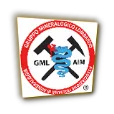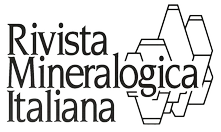Abstract 2017
Rivista Mineralogica Italiana > Abstract Articoli
Abstract ITALIAN MINERALOGICAL MAGAZINE nr. 1-2017 | |||||||||
MINERALS FROM CERCHIARA MINE (LA SPEZIA) | The Mn-Fe deposit of Cerchiara is located in the northern Apennines near Borghetto di Vara and Faggiona, La Spezia province, eastern Liguria, Italy. The manganese ore was exploited from the XVIII century up to the first half of the XX century. The dumps of the mine along the Redarena river host an outstanding variety of rare ad new mineral species, which formed mostly by circulation of hydrothermal fluids in fractures within the hematite and/or braunite ore. Cerchiara mine is the type-locality for seven mineral species, some of them very recently approved by the CNMNC of IMA: mozartite, brewsterite-Ba, caoxite, cerchiaraite-(Fe), cerchiaraite-(Mn), balestraite and manganiceladonite. | ||||||||
CHALCEDONY AND AGATE FROM THE PERMIAN VOLCANITES NEAR CIVEZZANO (TRENTO, ITALY) | At the foothills of the Dosso di Penedallo and Dos di Triangolo, located between Trento and Pergine Valsugana within the municipality of Civezzano, the andesitic lavas at the bottom of the Gruppo Atesino volcanic sequence (Lower Permian) are crossed by veins of chalcedony and agate. Despite being mentioned in the literature already in mid XIX Century, this mineralization was so far gone unnoticed. This paper reports the discovery and the results of the researches carried out by the authors between 2011 and 2016. This veins mainly containing botryoidal/ mammillary chalcedony and moss agate. Banded agates occur only in small portions of veins or filling the spaces between the fragments of volcanics breccias. The inner portions of the veins are covered with millimetric stretched hyaline quartz crystals, although crystals up to 7 cm long were also found with slight amethystine nuances. Phantom quartz, as well as tiny scepters or Japan twins have been also observed. Quartz may be associated with the following minerals: baryte, calcite, chlorite, hematite, goethite, pyrite and siderite. | ||||||||
MUNICH 2016: A SPECIAL EXHIBIT DEDICATED TO THE MINERALS FROM CANTON TICINO | This year a special exhibit dedi- cated to the minerals from Canton Ticino was organized at the Munich show. The exhibit was curated by Hannes Keilmann with the collaboration of a number of private mineral collectors from Switzerland, as well as by the Museum of Natural History of Bern and Lugano, by the ETH of Zurich and with the support of the Society of minerals and fos- sils collectors from Canton Ticino. | ||||||||
Abstract ITALIAN MINERALOGICAL MAGAZINE nr. 2-2017 | |||||||||
COPPER ORE DEPOSITS OF THE TUSCAN OPHIOLITES. GEOLOGY AND GENETIC INFERENCES | Ophiolites represent slices of oceanic litosphere occurring in mountain belts owing to the col- lision between oceanic and con- tinental tectonic plates. Typically, an ophiolitic sequence is composed by serpentinized peridotite, gabbro, and basalt; in some cases, volcanogenic massive sulfide (VMS) ores are associated with these rocks. Several small Cu ore deposits are hosted within Jurassic ophiolites in Tuscany; among them, only the Montecatini Val di Cecina deposit was successfully exploited. Ore bodies are mainly formed by bornite, chalcopyrite, and minor chalcocite. This mineral assemblage is different from that reported from Ligurian ophio- litic ore deposits, where pyrite and chalcopyrite are the main ore minerals. Two kinds of occurrence of chalcopyrite ± bornite ores can be distinguished: i) veins and stockworks hosted in gabbro or at the contact between serpentinite and basalt, in gabbro dykes within serpentinite or in the serpentinite and ii) masses and nodules (from few mm to tens of meters) hosted in tectonized gabbro, sometimes close to the contact between ba- salt and serpentinite, or in shear zone within serpentinite. Locally, supergene alteration gave rise to the precipitation of native copper and cuprite. Ore deposits hosted within Jurassic ophiolites are related to hydrothermal systems within oceanic litosphere; however, the peculiar mineral assemblage reported for Tuscan ore deposits and their differences with respect to similar mineralization from Liguria requires further studies. | ||||||||
CRETAIO. OLD MINING COPPER PROSPECT NEAR PRATA MASSA MARITTIMA (GR) | Thirty-three different mineral spe- cies have been identified in the small Cu prospect of Cretaio, near the hamlet of Prata, Massa Marittima, Grosseto Province, Tuscany. The supergenic alteration of Cu sulfides (bornite, chalcocite, covellite, and chalcopyrite) gave rise to the crystallization of several secondary minerals. Among them, connellite and spangolite are here described for the first time from Tuscan ophiolites. In addition, the copper phosphate libethenite is reported. Finally, a new mineral species, closely related to chalcophyllite, has been recently approved by the IMA-CNMNC. | ||||||||
MONTECATINI VAL DI CECINA: THE MINERALOGICAL COLLECTION OF THE NATURAL HISTORY MUSEUM OF THE PISA UNIVERSITY | During the XIX Century, the Montecatini Val Cecina mine was considered as one of the richest copper mines in Europe, owing to the occurrence of large concentrations of high-grade sulfides (bornite, chalcocite, and chalcopyrite). In addition, it was well-known for the presence of good specimens of cal- cite and crystallized silicates (e.g., analcime, laumontite, natrolite). Several new mineral species were described in the mid-XIX Century (e.g., picroanalcime, portite, savite, and sloanite); unfortunately, all these minerals were found to correspond to previously known species and consequently they were discredited. The mineralogical collections of the Natural History Museum of the Pisa University keep 158 specimens from Montecatini Val di Cecina. The critical re-examination of this collection gives interesting insights on the mineralogy of this locality as well as on the mineralogical studies performed on these samples by the mineralogists of the Pisa University in the second half of the XIX Century. | ||||||||
Abstract ITALIAN MINERALOGICAL MAGAZINE nr. 3-2017 | |||||||||
THE HISTORY OF AN EXCEPTIONAL ANATASE FROM GORB, VALLESE, SWITZERLAND | A number of exceptional specimens of anatase from Binn valley were present in the historical mineral collection of Giancarlo Fioravanti. Among these, one was purchased by the author of this paper: the specimen is unique, has severals gem quality crystals, reaching 8,2 millimeters in length. The specimen shows an interesting history, identified from the old la- bel associated with it. On 1967, the specimen was purchased by the Natural History Museum of London from the “Shales Gems & Minerals” shop and after it was exchanged by Giancarlo Fioravanti with the Museum of London. | ||||||||
MOLIBDENITEFROM ALPI APUANE. A RESEARCH SPANNING THIRTY YEARS | Molybdenite was first identified from Apuan Alps in a specimen collected in 1985 from the Vagli area. However, the actual sampling site remained unknown. Coupling geological as well as geochemical data, the original sampling site has been recently located. Molybdenite occurs as cm-sized leadgrey sub-metallic masses in quartz veins within a microcrystalline pyrite ore body embedded in the Scisti sericitici formation (Cretaceous – Eocene) belonging to the Apuan Alps metamorphic complex. This is the first identification of molybdenite from the hydrothermal veins of Apuan Alps. | ||||||||
FLUORITE FROM CORVARA IN VAL SARENTINO (BOLZANO): LATEST FINDINGS  | The fluorite and leadzinc-containing sulphide deposit of Corvara (Rabenstein) is located in Val di Pennes, the northern continuation of the Sarn Valley, north of Bolzano and has been an important mining centre since ancient times. This work aims at demonstrating that even in an unfavorable environment, such as closure of the once numerous mines and quarries and the progressive impoverishment of important samples both from the scientific and aesthetic points of view in the most famous and historical places, it is still possible to find significant samples which are in no way inferior to those of foreign origin. In fact, research conducted by experts combining their knowledge in the mineralogical field with a fair amount of patience, perseverance and hard work, can lead to highly satisfactory results. The detailed and comprehensive study on this deposit is due to Morgante (1940 and 1964) from which we have largely drawn on historical, geological, mining and mineralogical information reported below. | ||||||||
During the last years, mineral specimens lab-preparation greatly improved in importance and popularity in mineral market and collecting. Nevertheless, not much information has been published and documented on this topic up to now. Significant specimens preparation was already performed quietly during the 19th century. The beginning of the “modern times” could be set since 1962 when US mineral dealer and collector Herbert Obodda used for the first time a sandblasting ma- chine in the process of cleaning and preparing mineral specimens. Brian Lees, mineral specimens miner and dealer from Colorado, in the beginning of the 90s was instrumental to elevate mineral specimens preparation at a professional level. The foundation in 2013 in Milan (Italy) of the European most important professional laboratory for mineral specimens preparation (M.C.P.), allowed at an international scale a significant improvement of the techniques and new perspectives for their application. After some historical notes,this article deals with the trimming techniques which, through the use of pneumatic pens, diamond saws, and manual or hydraulic presses, allows to safely remove from specimens exceeding matrix and crystals parts, getting to the best possible aesthetics and balance. | |||||||||
WENKITE, A RARE MINERAL FROM CANDOGLIA QUARRIES, MERGOZZO (VERBANO-CUSIO- OSSOLA) | Wenkite is well-known for its rarity, having being found in only one other locality in addition to Candoglia, that represents its type locality. The researches performed by one of the author, many years later the original finding, have permitted to find again a fair amount of specimens and to ascertain the presence of this mineral in an area much larger than originally supposed | ||||||||
Abstract ITALIAN MINERALOGICAL MAGAZINE nr. 4-2017 | |||||||||
DEMANTOID GARNET MINERAL AND GEMSTONE | Demantoid, which is the green va- riety of the andradite mineral, rep- resents one of the rarer and most appreciated gemstones among garnets. Demantoid was first dis- covered in the mid of the 1800s in Russia and it was very popular in Russia and Europe from the end of the 1800s and the beginning of the 1900s. One of the most famous de- mantoid deposits, well-known also worldwide, is the Val Malenco, in the province of Sondrio, northern Italy. Very nice crystals of deman- toid were found in this valley and thousands of carats of fine faceted gems from this area have entered the market over the years. New commercially important deposits have been recently found in Namibia and Madagascar. The determina- tion of the origin of various deman- toids is possible on the basis on the different inclusions they show and on their trace-element composition. | ||||||||
At the beginning of 2009 one of the richest demantoid deposit in the world was discovered at Ante- tezambato, in northern Madagascar. The deposit is of skarn-rocks type, similar to the ones occurring in Namibia, and different from the serpentinite-type typical of the Ural mountains localities and of the Malenco valley, in Italy. In the period 2009-2010, tens of ki- los of gemrough and hundreds of nice mineral specimens were produced, with crystals occasionally reaching up to 3 cm in diameter. The occurring garnet is rather pure andradite, with colors ranging from green (demantoid) to yellow (topazolite). At the end of 2010 all manual excavations stopped in view of the mining difficulties related to the seawater flooding daily the area. In 2013 and 2014 a Malagasy Joint Venture perfor- med two seasons of mechanized mining with quiet good production results; nevertheless at presenall works are stopped because of some bureaucratic troubles, and a new excavation is expected not before one or two years. | |||||||||
Sprays of very thin acicular crystals, veinlets and crusts of pale blue to greenish minerals belonging to the mixite group occur in the greisen facies of Cuasso al Monte granitic granophyre. Microprobe analyses carried out on several specimens revealed different terms of the series of agardite in the Cuasso al Monte granophyre. In particular, together with agardite-(Ce), both agardite-(Y) and agardite-(Nd) were identified. These minerals are characterized by a high PbO content, related to their solid solution with plumboagardite. | In April 2013, two enthusiastic minerals collectors discovered some interesting titanite crystals with gray, sky blue colo with acute terminations and crystal aggregates up to few millimeters hosted in pegmatite cavities near the famous Grotta d’Oggi locality, in the Bovalico Valley between the villages of San Piero and Sant’Ilario, Elba island. | ||||||||
The occurrence of prehnite from Monte Porro quarry, Aulla, is here reported. Prehnite forms hemispherica aggregates of tabular crystals, with vitreous luster and a light green color. Other minerals collected in this locality are calcite, “chlorite”,epidote, pumpellyite and quartz. | WULFENITE, MINERALOGICAL NOVELTIES FROM BOTRO AI MARMI, CAMPIGLIA MARITTIMA (LI). | Wulfenite was recently identified from the Maffei mine, Botro ai Marmi, Campiglia Marittima, Leg- horn, as tabular crystals, up to 2,5 mm in size, with color ranging from colorless to honey-yellow to orange. In the specimens studied, wulfenite occurs in molybde- nite-bearing quartz veins embedded in the monzogranite; in the small vugs, it is associated with halloysite-7Å, halloysite-10Å, and “limonite” | |||||||
In the cavities of the Carrara marble, together with sulphides, sulphosalts and quartz, the latter already subject of articles in the Rivista Mineralogica Italiana, minerals that form good-sized crystals, such as sulphur, fluorite, rutile, calcite, dolomite, gypsum, celestine, albite and adularia, are present as well. In addition to these species, there are other minerals in smaller crystals, including anatase, azurite and malachite, this last very appreciated and sought after by collectors of marble minerals for their chromatic and aesthetic characteristics. | |||||||||
















